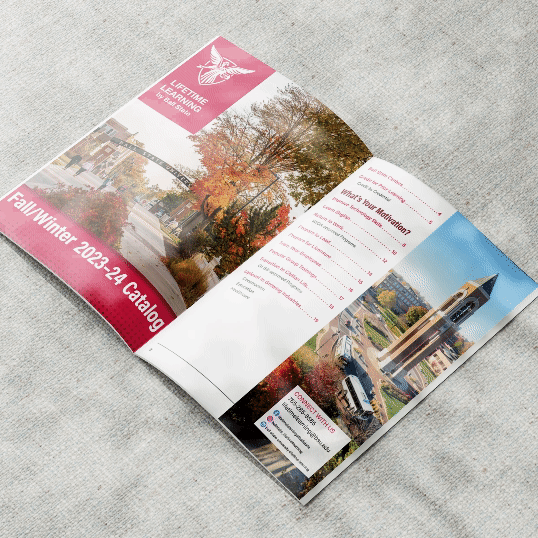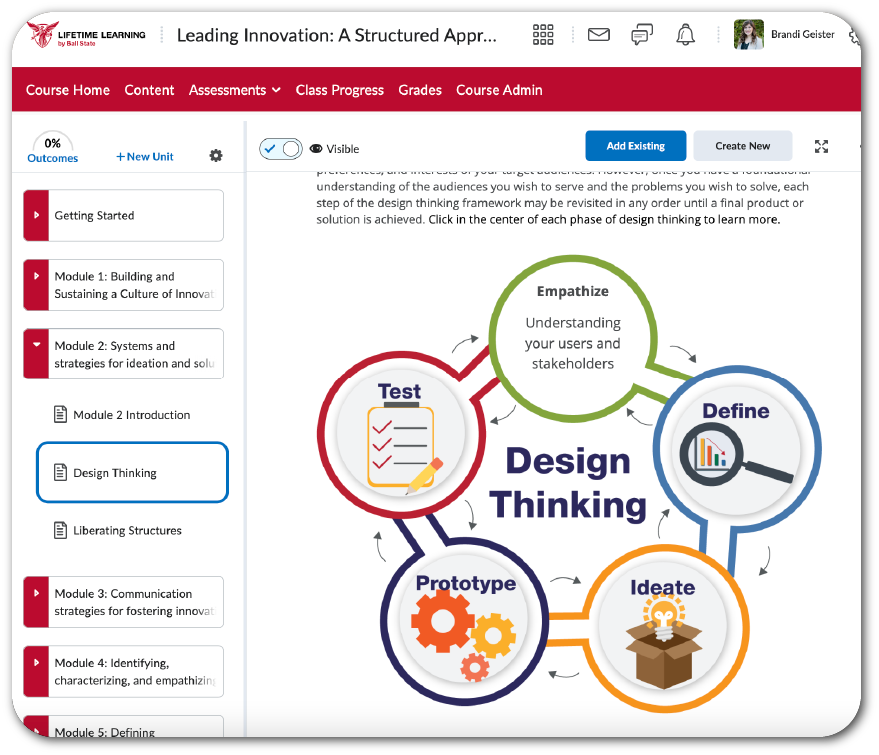Guiding Effective Online Learning

Driving
Lifelong Learning
Ball State University is on a mission to not only providing top-tier educational experiences for full-time learners, but also to support learners at all stages of life. for community outreach and supporting learners in all phases of life. The university created Destination 2040, a Design Thinking and strategic planning initiative to help them find solutions to help better support their students. After brainstorming, problem solving, and lots of sticky notes, the Division of Lifetime Learning was born, in conjunction with several other missions. Lifetime Learning was created to expand educational offerings to include non-credit courses, certificate programs, and customized training for adult learners.


Who is the "Adult Learner"
According to university research, the adult learner is practical and hungry for information and appreciates instant gratification. They are looking to improve their skills, facilitate work habits, and boost their confidence. They also have many different motivations for continuing their learning– advancement, re-certifications, and personal/professional goals. They are also at many different stages in their life and juggling many things – work, families, friends, school, pets, etc. They are looking to be impressed, they need flexibility to manage their other obligations, they require support, they like immediate support, they like control of their time and need to understand the "why." Why am I doing this, why is this relevant, and why is it important for me to know?
Getting Started
My mission: Create sophisticated and intuitive courses for adult learners, showcasing ease of access, flexibility, immediate support and gratification to facilitate lifelong learning. First, some constraints:
- When I began this role, I was not an expert in best practices and pedagogy in adult education. To tackle this constraint, my solution was to continue my education. I found podcasts, blogs, and teaching resources to learn more. I also found a mentor in another department on campus who specialized in online learning pedagogy. The mentorship was mutually beneficial. We agreed to meet weekly, and she helped me incorporate scientifically-backed educational frameworks into my consulting feedback for subject matter experts (SMEs) and I consulted her on web design and development. With her help, I was able to create a number of resources prompting SMEs through the course mapping process, and it helped me optimize my course design for information retention and better learning. I helped her create a library of LMS templates for on-campus courses.
- Our timeline was very short. We were learning as we went, and the work was very fast-paced. The pilot initiative was driven in the spirit of innovation, recognizing that experimentation, evolution, and learning from our mistakes are all valuable parts of the process.
- In the beginning, our team was REALLY small. Our development team started with just 2 people and slowly expanded in our first year. It was an all-hands-on-deck initiative.
Using ADDIE For Course Design
ADDIE stands for Analysis, Design, Develop, Implement, and Evaluate. It's one of the best-known course design models and documents the process of strategically planning course design and implementation. It's also incredibly similar to the Design Thinking method, a process I use extensively in UX/UI design projects. I've outlined our steps with ADDIE below.
Identifying problems, goals, gaps, competitors, & stakeholder needs
Aligning content with stakeholder needs, evaluation mapping, & strategizing communication
Securing technology for learning, developing all course assets and designing courses from start to finish
Placing finished product into university LMS (Brightspace), and executing plans for communication and participation
Proofreading, user testing, usability testing, and providing points of improvement
Additional Frameworks
We also applied Bloom's Taxonomy, Backwards Design, Transparency in Learning and Teaching (TILT), and the Universal Design for Learning (UDL) to guide curricula development. Each framework was used in tandem to provide advice for SMEs when creating curriculum maps for each course.
For example, Backward Design focuses on goal-oriented design. It prioritizes intended learning outcomes (objectives) instead of topics to be covered. Bloom's Taxonomy was used to provide clear, effective, measurable learning objectives for learners as they move through each module of each course. The TILT framework provides set teaching strategies focusing on transparency in teaching. This helps give learners context for WHY they are completing assignments, readings, activities, etc. The UDL framework gives course developers guidelines for creating accessible learning experiences for all types of learners, regardless of ability or disability. It helps prevent unnecessary learning barriers.
What Does it Look Like?
If you've ever taken a college course, you will know that many subject matter experts use their LMS space (like in Brightspace, Canvas, or Blackboard) as a dumping ground for videos, PowerPoints, photos, the occasional reading, and assignments. A typical learning experience outside of a university setting- Udemy, for example- often only offer video-guided training exercises with downloadable exercises/ assignments.
Research shows that adult learners often prefer feedback, they like versatility and freedom to do trainings on their own time, they prefer to know WHY they are learning topics (instead of just HOW-TO), and more.
In the Lifetime Learning Division, I designed and built courses to achieve these learning goals for adult learners. Our courses were completely online and asynchronous, with subject matter experts in their field to reach out to and connect with, and simple/ clean design solutions that were easy to navigate for people of all demographics.
The vision for these online courses was to read almost like a novel. I treated online learning like a long-form storytelling project. I harnessed the power of learning frameworks, such as TILT, Universal Design for Learning, Bloom's Taxonomy, and Backwards Design to coach subject matter experts through designing a narrative to their courses. Each course had a narrative arc with a well-planned course map, clear and concise learning objectives, and transparent assignments explaining why the topics we were covering were relevant. In this process, Ball State's online courses were transformed from a dumping ground to interactive learning experiences. The attached file showcases my design process from start to finish.
Prototyping
Each page of each course was written in a narrative style- complete with measurable objectives, relevant assignments and activities, visuals, and multimedia elements to appeal to every learning style. The mid-fidelity prototypes were designed and developed using Figma. The next steps of this process were testing, revisions, and development in Webflow.

Development & Launch
After development in Webflow, course pages were placed into the Course LMS, Brightspace. From there, each of the courses were to go through rigorous proofreading and final testing before going live and being sold to Lifetime Learning Students.





Building a Thorough Story World
